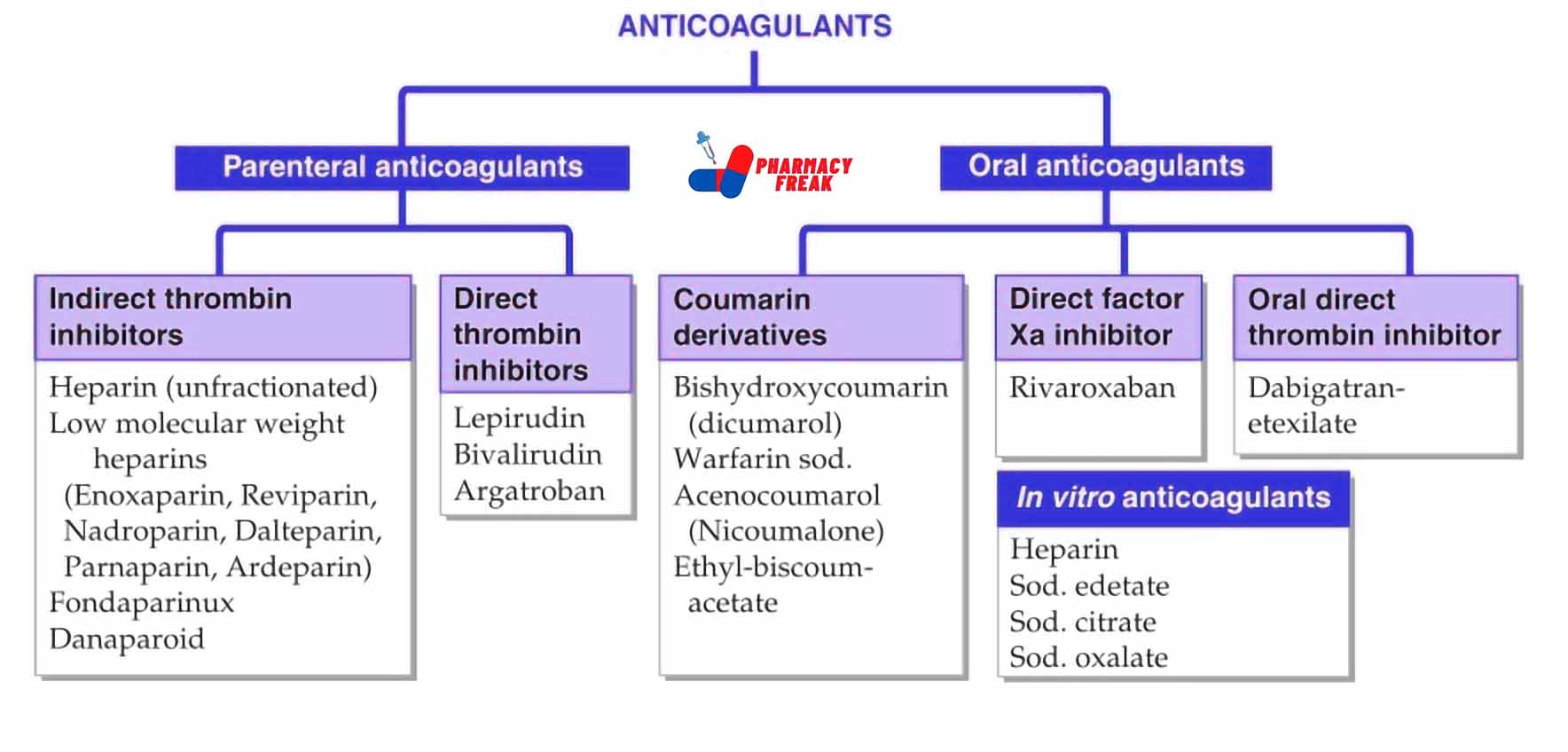Anticoagulants are medicines that stop blood from clotting too quickly. They help keep blood flowing smoothly. These drugs don’t actually thin the blood, but they stop clots from forming or getting bigger. Doctors use them to treat and prevent serious health problems like heart attacks, strokes, and blood clots in the lungs or legs. Anticoagulants can be life-saving when used properly.
Table of Contents
KD Tripathi Classification
- Parenteral anticoagulants
- Indirect thrombin inhibitors
- Heparin (unfractionated)
- Low molecular weight heparins (Enoxaparin, Reviparin, Nadroparin, Dalteparin, Parnaparin, Ardeparin)
- Fondaparinux
- Danaparoid
- Direct thrombin inhibitors
- Lepirudin
- Bivalirudin
- Argatroban
- Indirect thrombin inhibitors
- Oral anticoagulants
- Coumarin derivatives
- Bishydroxycoumarin (dicumarol)
- Warfarin sod.
- Acenocoumarol (Nicoumalone)
- Ethyl-biscoum-acetate
- Direct factor Xa inhibitor
- Rivaroxaban
- Oral direct thrombin inhibitor
- Dabigatran-etexilate
- Coumarin derivatives
- In vitro anticoagulants
- Heparin
- Sod. edetate
- Sod. citrate
- Sod. oxalate
Based on Mechanism of Action
Anticoagulants are mainly grouped by how they work in the body.
a) Vitamin K Antagonists (VKAs)
These block the action of vitamin K. Vitamin K helps blood clot.
- Example: Warfarin
VKAs need regular blood tests to check dosage levels.
b) Direct Oral Anticoagulants (DOACs)
These work faster than VKAs and don’t need frequent blood tests.
- Two types:
- Direct Thrombin Inhibitors: Block thrombin directly.
- Example: Dabigatran
- Factor Xa Inhibitors: Block factor Xa, a key clotting protein.
- Examples: Apixaban, Rivaroxaban, Edoxaban
- Direct Thrombin Inhibitors: Block thrombin directly.
c) Heparins
These are older and often given by injection.
- Two types:
- Unfractionated Heparin (UFH): Works quickly, used in hospitals.
- Low Molecular Weight Heparin (LMWH): Safer and longer-lasting.
- Examples: Enoxaparin, Dalteparin
Based on Route of Administration
Some anticoagulants are taken by mouth. Others are given as injections.
- Oral anticoagulants: Warfarin, Dabigatran, Rivaroxaban
- Injectable anticoagulants: Heparin, Enoxaparin
Natural Anticoagulants in the Body
Our body also makes its own anticoagulants.
- Examples: Antithrombin III, Protein C, Protein S
These help control clotting naturally.
Uses of Anticoagulants
Anticoagulants are used to manage many conditions. Here are the most common uses:
- Preventing stroke in patients with atrial fibrillation
People with irregular heartbeats are at high risk for blood clots. - Treating deep vein thrombosis (DVT)
Anticoagulants help dissolve clots in deep veins, usually in the legs. - Managing pulmonary embolism (PE)
They stop the growth of clots in the lungs and prevent new ones. - After surgeries like hip or knee replacement
These drugs reduce the chance of clots forming after major surgeries. - Preventing blood clots in people with heart conditions
Especially those with artificial heart valves or a history of heart attack. - During dialysis or blood transfusions
Anticoagulants are used to keep blood from clotting in medical machines.
Reference
- Classification of Anticoagulant- KD Tripathi
- What Are the Types of Anticoagulants?- Web-md
Related Links

I am pursuing MBA in pharmaceutical management from NIPER Hyderabad with a strong academic record and proven success in national-level pharmacy entrance exams. I secured AIR 61 in NIPER 2024 (MS/M.Pharm) and AIR 27 in NIPER MBA, along with AIR 147 in GPAT 2024 and AIR 907 in GPAT 2023. I also achieved AIR 6 in AIIMS CRE-2025 for Drug Store Keeper and was selected as a Pharmacist (AIR 61) for ESIC. Additionally, I was the Runner-Up in Round 2 of the EY Case Study Competition.
At PharmacyFreak.com, I aim to guide future pharmacists through expert content, exam strategies, and insightful resources based on real experience and academic excellence.
Mail- harsh@pharmacyfreak.com

